TOYOTA IQ 2013 Owners Manual
Manufacturer: TOYOTA, Model Year: 2013, Model line: IQ, Model: TOYOTA IQ 2013Pages: 372, PDF Size: 7.77 MB
Page 281 of 372
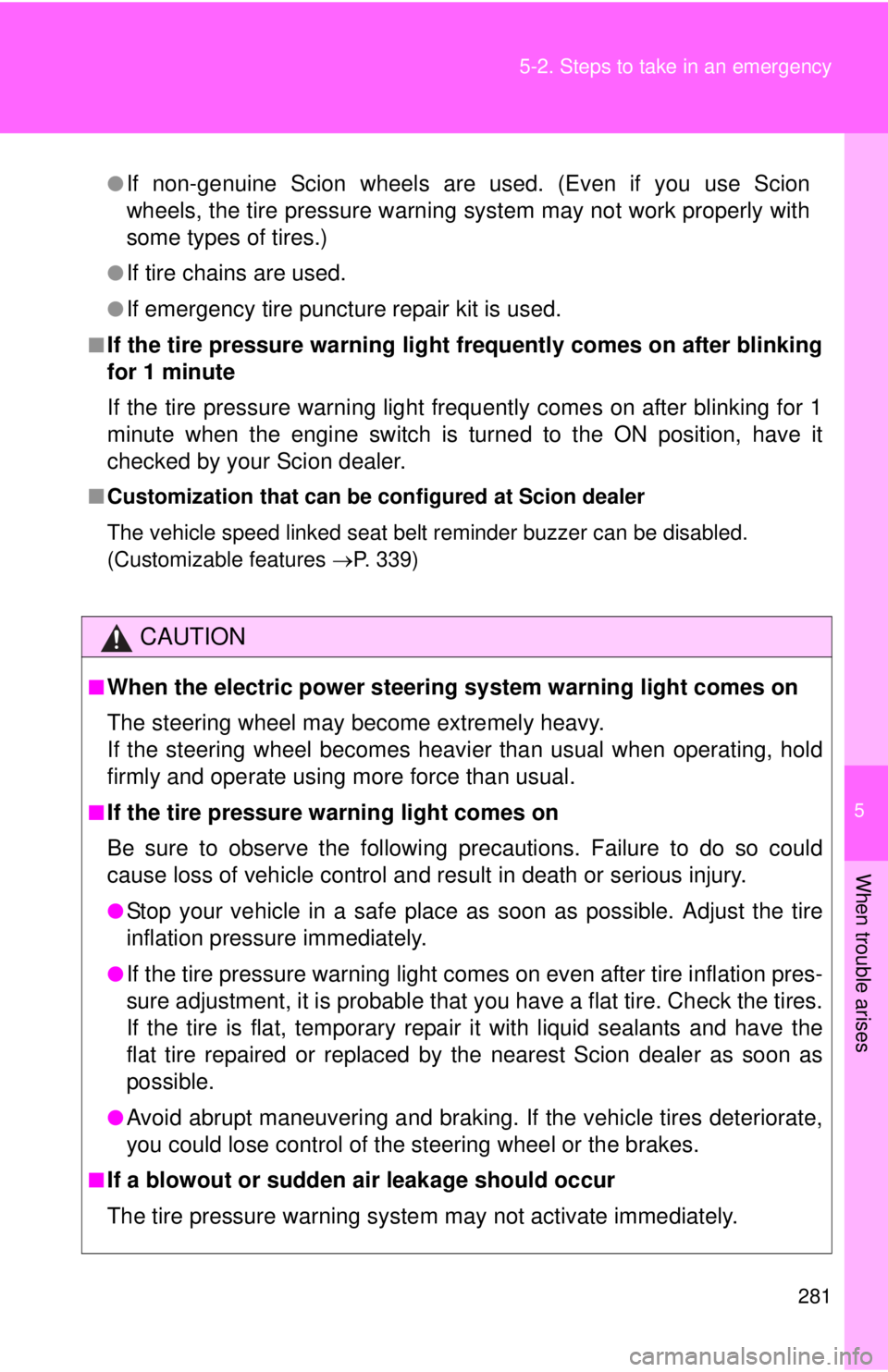
5
When trouble arises
281
5-2. Steps to take in an emergency
●If non-genuine Scion wheels are used. (Even if you use Scion
wheels, the tire pressu
re warning system may not work properly with
some types of tires.)
●If tire chains are used.
●If emergency tire puncture repair kit is used.
■If the tire pressure warning light frequently comes on after blinking
for 1 minute
If the tire pressure warning light frequently comes on after blinking for 1
minute when the engine switch is turned to the ON position, have it
checked by your Scion dealer.
■ Customization that can be configured at Scion dealer
The vehicle speed linked seat belt reminder buzzer can be disabled.
(Customizable features P. 339)
CAUTION
■When the electric power steering system warning light comes on
The steering wheel may become extremely heavy.
If the steering wheel becomes heavier than usual when operating, hold
firmly and operate using more force than usual.
■If the tire pressure warning light comes on
Be sure to observe the following precautions. Failure to do so could
cause loss of vehicle control and result in death or serious injury.
●Stop your vehicle in a safe place as soon as possible. Adjust the tire
inflation pressure immediately.
●If the tire pressure warning light comes on even after tire inflation pres-
sure adjustment, it is pr obable that you have a flat tire. Check the tires.
If the tire is flat, temporary repair it with liquid sealants and have the
flat tire repaired or replaced by the nearest Scion dealer as soon as
possible.
●Avoid abrupt maneuvering and braking. If the vehicle tires deteriorate,
you could lose control of the steering wheel or the brakes.
■If a blowout or sudden air leakage should occur
The tire pressure warning syste m may not activate immediately.
Page 282 of 372
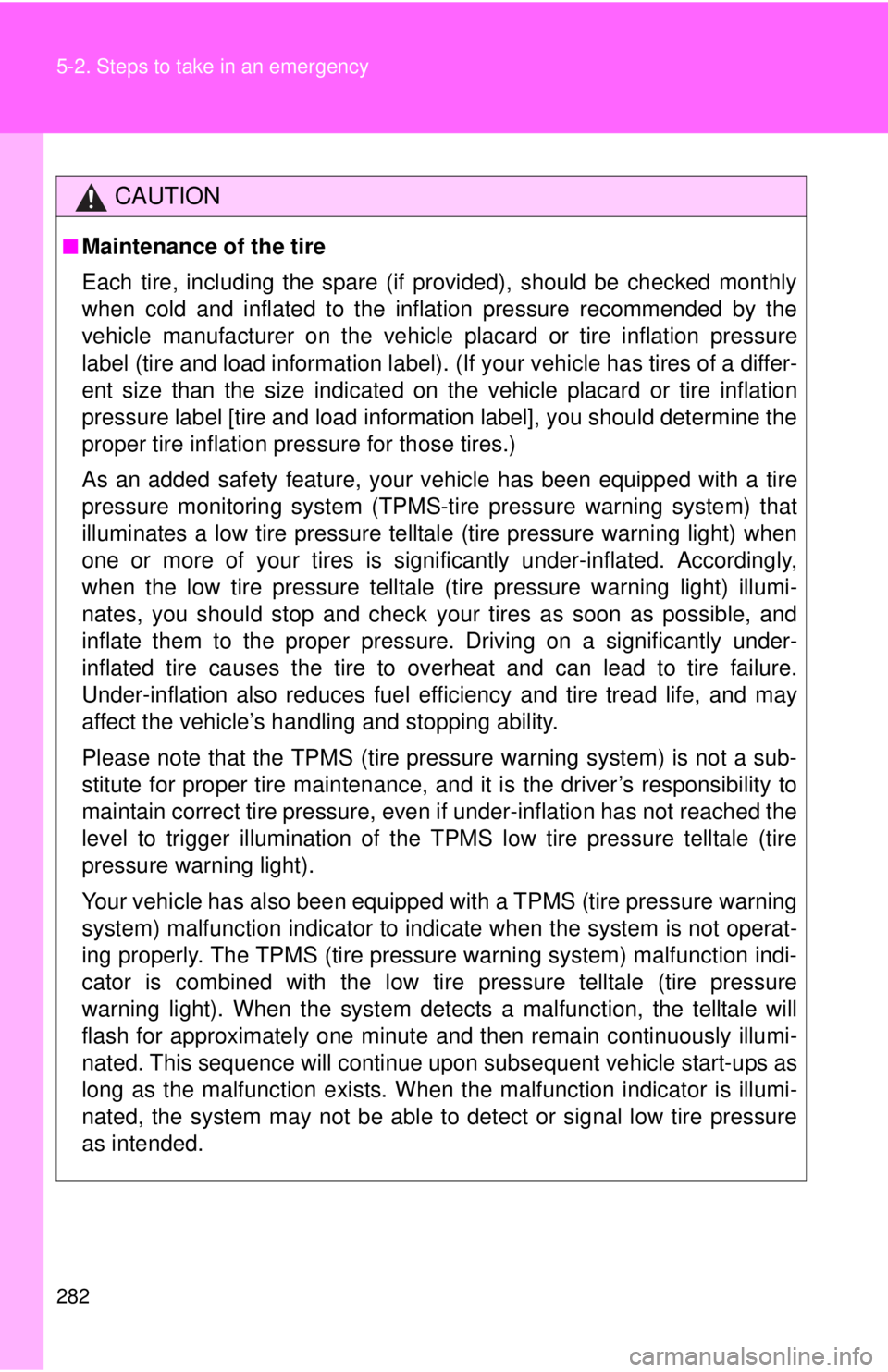
282 5-2. Steps to take in an emergency
CAUTION
■Maintenance of the tire
Each tire, including the spare (if provided), should be checked monthly
when cold and inflated to the inflation pressure recommended by the
vehicle manufacturer on the vehicle placard or tire inflation pressure
label (tire and load information label). (If your vehicle has tires of a differ-
ent size than the size indicated on the vehicle placard or tire inflation
pressure label [tire and load information label], you should determine the
proper tire inflation pr essure for those tires.)
As an added safety feature, your vehicle has been equipped with a tire
pressure monitoring system (TPMS-ti re pressure warning system) that
illuminates a low tire pressure telltal e (tire pressure warning light) when
one or more of your tires is significantly under-inflated. Accordingly,
when the low tire pressu re telltale (tire pressure warning light) illumi-
nates, you should stop and check your tires as soon as possible, and
inflate them to the proper pressure. Driving on a significantly under-
inflated tire causes the tire to overheat and can lead to tire failure.
Under-inflation also reduces fuel effi ciency and tire tread life, and may
affect the vehicle’s handling and stopping ability.
Please note that the TPMS (tire pressure warning system) is not a sub-
stitute for proper tire main tenance, and it is the driver’s responsibility to
maintain correct tire pressure, even if under-inflation has not reached the
level to trigger illu mination of the TPMS low tire pressure telltale (tire
pressure warning light).
Your vehicle has also been equipped with a TPMS (tire pressure warning
system) malfunction indicator to indi cate when the system is not operat-
ing properly. The TPMS (tire pressure warning system) malfunction indi-
cator is combined with the low tire pressure telltale (tire pressure
warning light). When the system det ects a malfunction, the telltale will
flash for approximately one minute an d then remain continuously illumi-
nated. This sequence will continue upon subsequent vehicle start-ups as
long as the malfunction exists. When the malfunction indi cator is illumi-
nated, the system may not be able to detect or signal low tire pressure
as intended.
Page 283 of 372
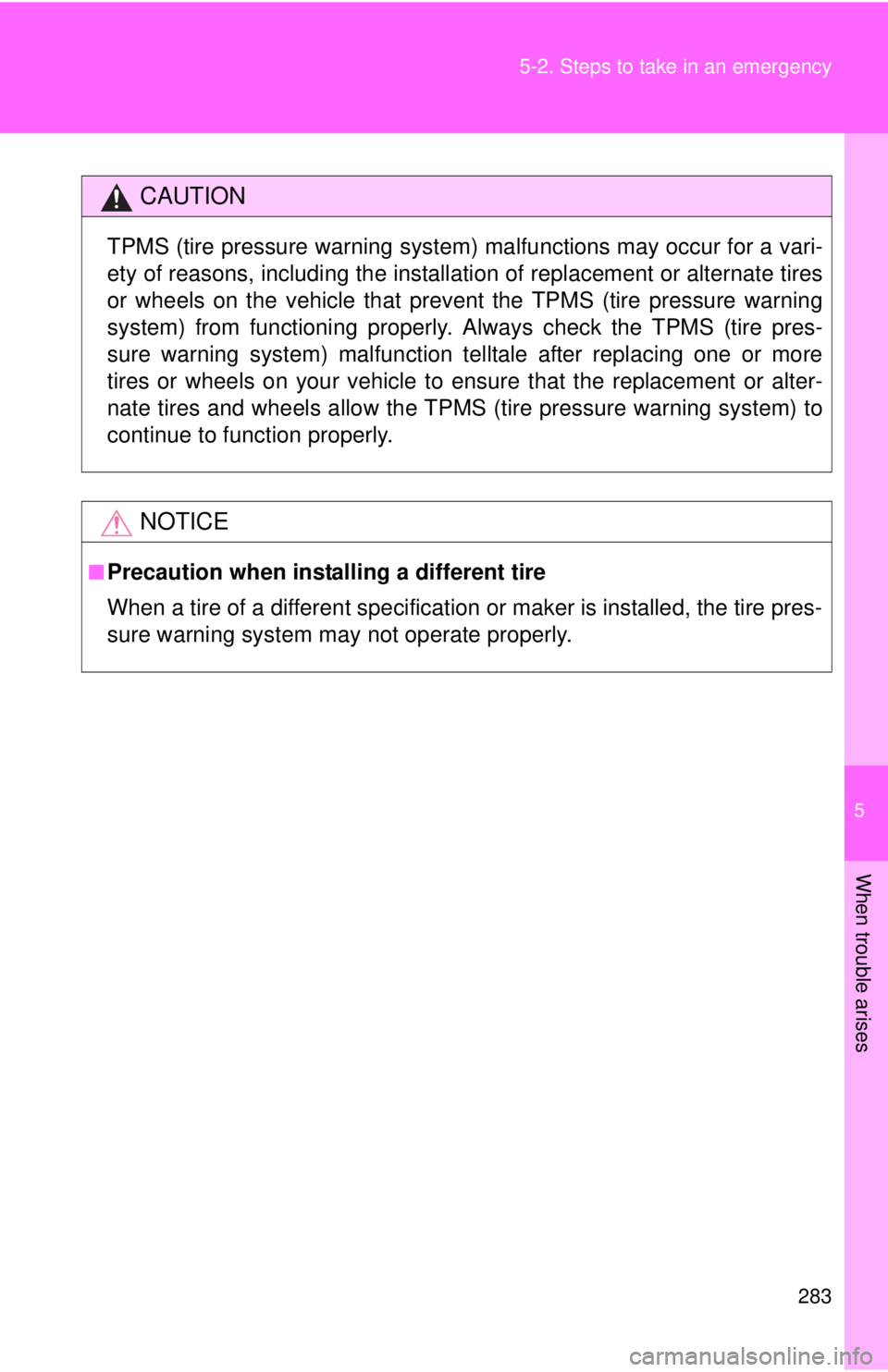
5
When trouble arises
283
5-2. Steps to take in an emergency
CAUTION
TPMS (tire pressure warning system) malfunctions may occur for a vari-
ety of reasons, including the installati
on of replacement or alternate tires
or wheels on the vehicle that prevent the TPMS (tire pressure warning
system) from functioning properly. Always check the TPMS (tire pres-
sure warning system) malfunction te lltale after replacing one or more
tires or wheels on your vehicle to ensure that the replacement or alter-
nate tires and wheels allow the TPMS (tire pressure warning system) to
continue to function properly.
NOTICE
■Precaution when installing a different tire
When a tire of a different specification or maker is installed, the tire pres-
sure warning system may not operate properly.
Page 284 of 372
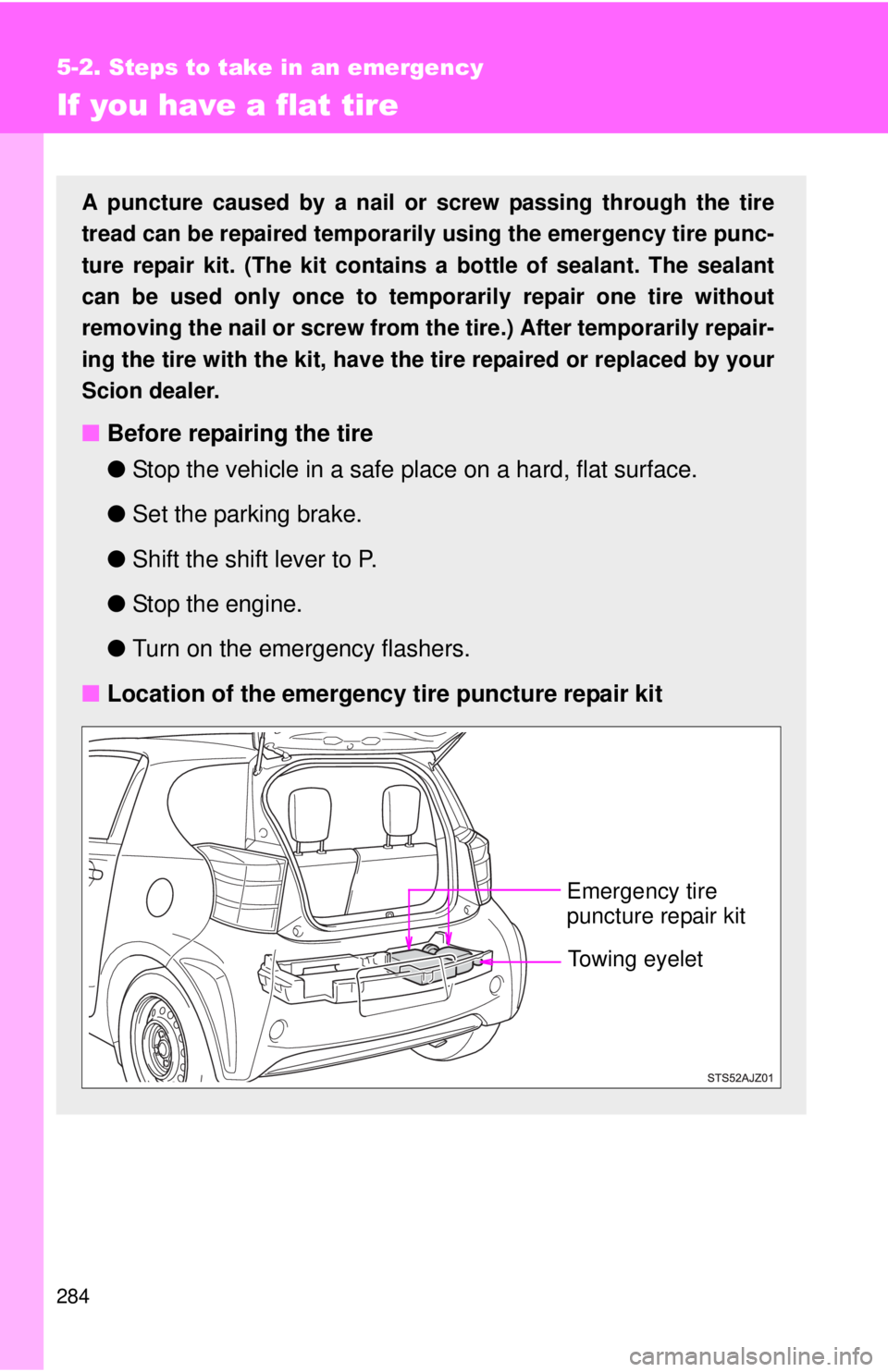
284
5-2. Steps to take in an emergency
If you have a flat tire
A puncture caused by a nail or screw passing through the tire
tread can be repaired temporarily using the emergency tire punc-
ture repair kit. (The kit contains a bottle of sealant. The sealant
can be used only once to temporarily repair one tire without
removing the nail or screw from the tire.) After temporarily repair-
ing the tire with the kit, have the tire repaired or replaced by your
Scion dealer.
■ Before repairing the tire
●Stop the vehicle in a safe pl ace on a hard, flat surface.
● Set the parking brake.
● Shift the shift lever to P.
● Stop the engine.
● Turn on the emergency flashers.
■ Location of the emergency tire puncture repair kit
Emergency tire
puncture repair kit
Towing eyelet
Page 285 of 372
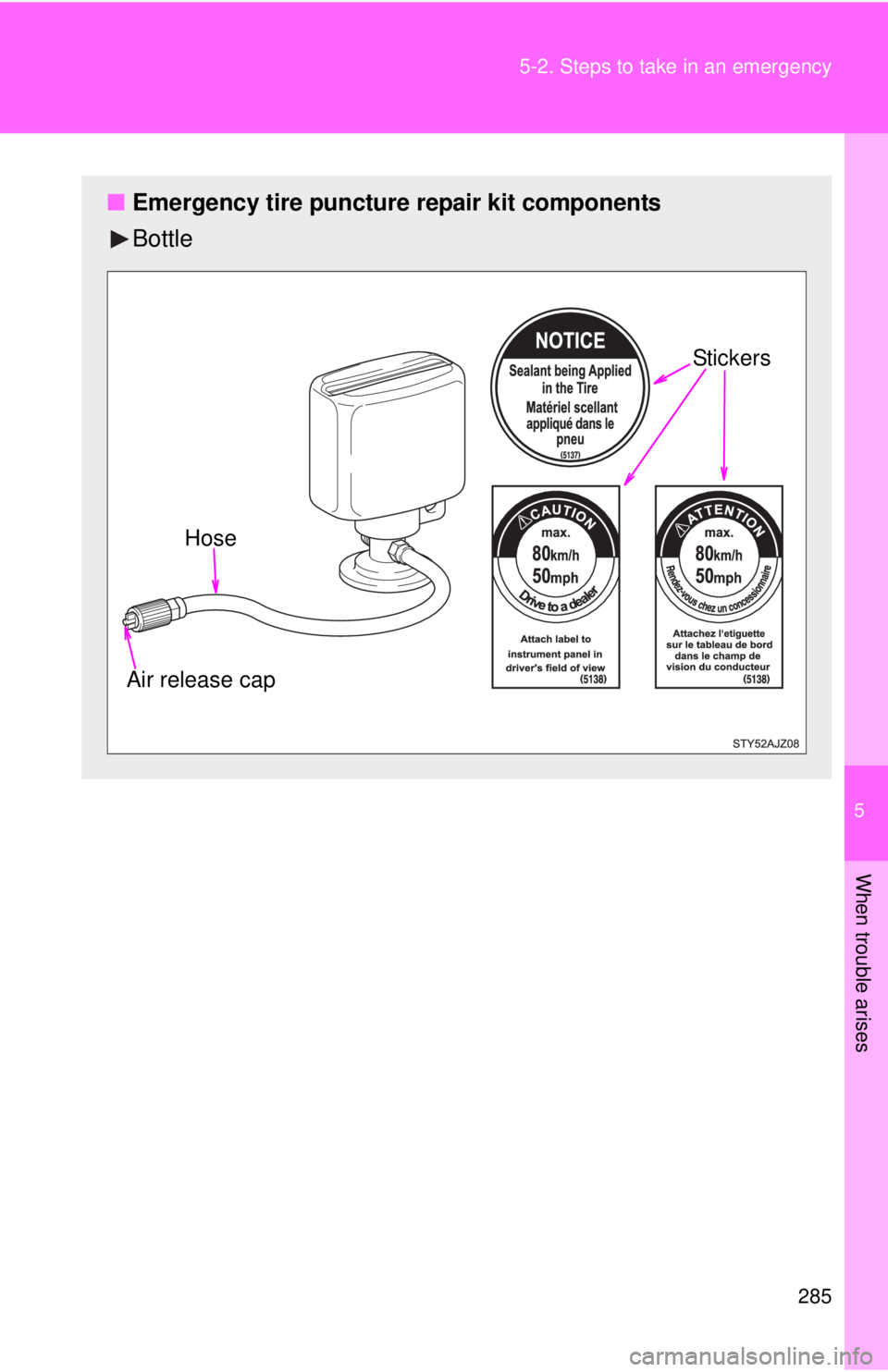
5
When trouble arises
285
5-2. Steps to take in an emergency
■
Emergency tire puncture repair kit components
Bottle
Air release cap Hose Stickers
Page 286 of 372
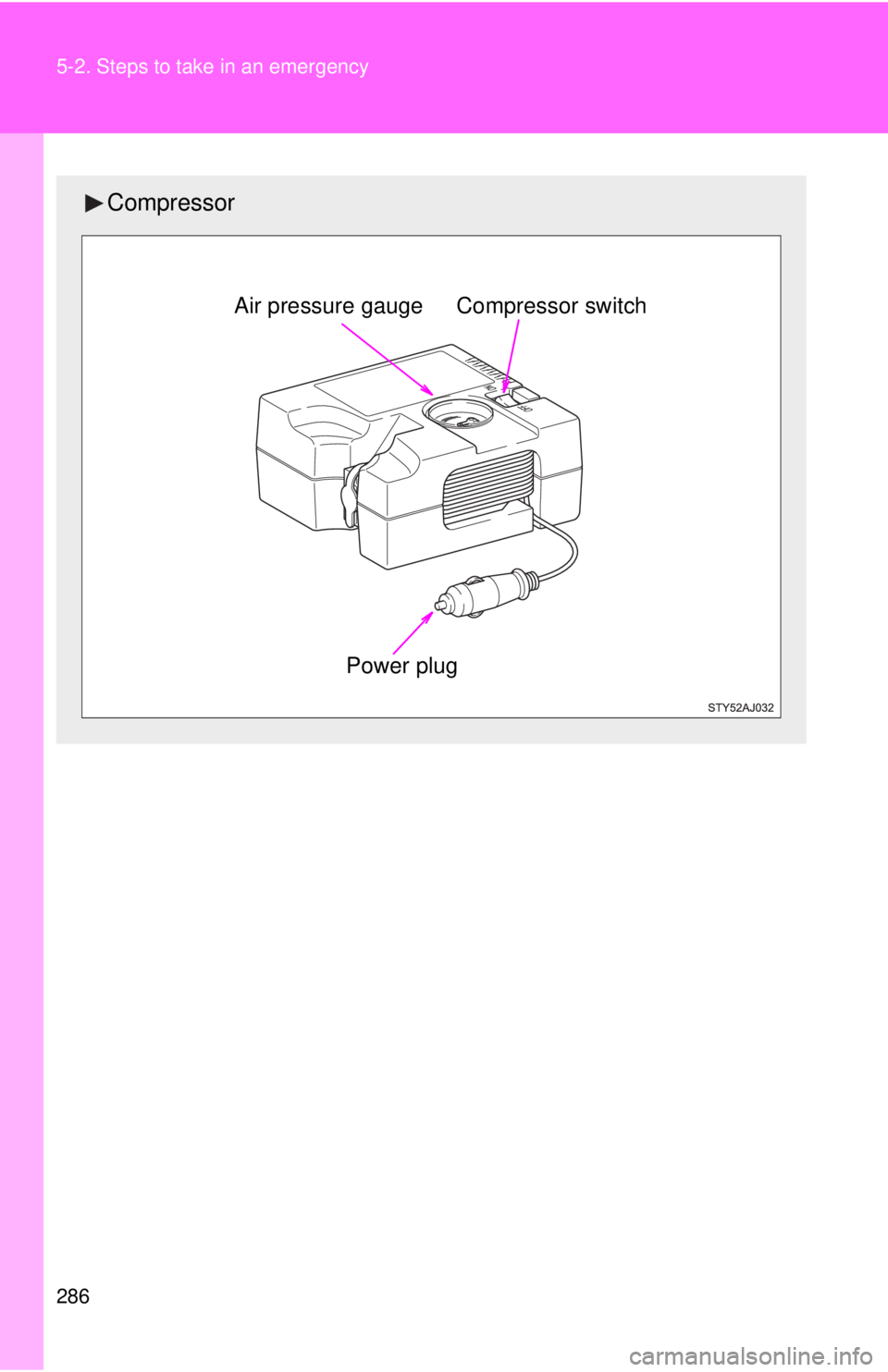
286 5-2. Steps to take in an emergency
Compressor
Power plug
Air pressure gauge Compressor switch
Page 287 of 372
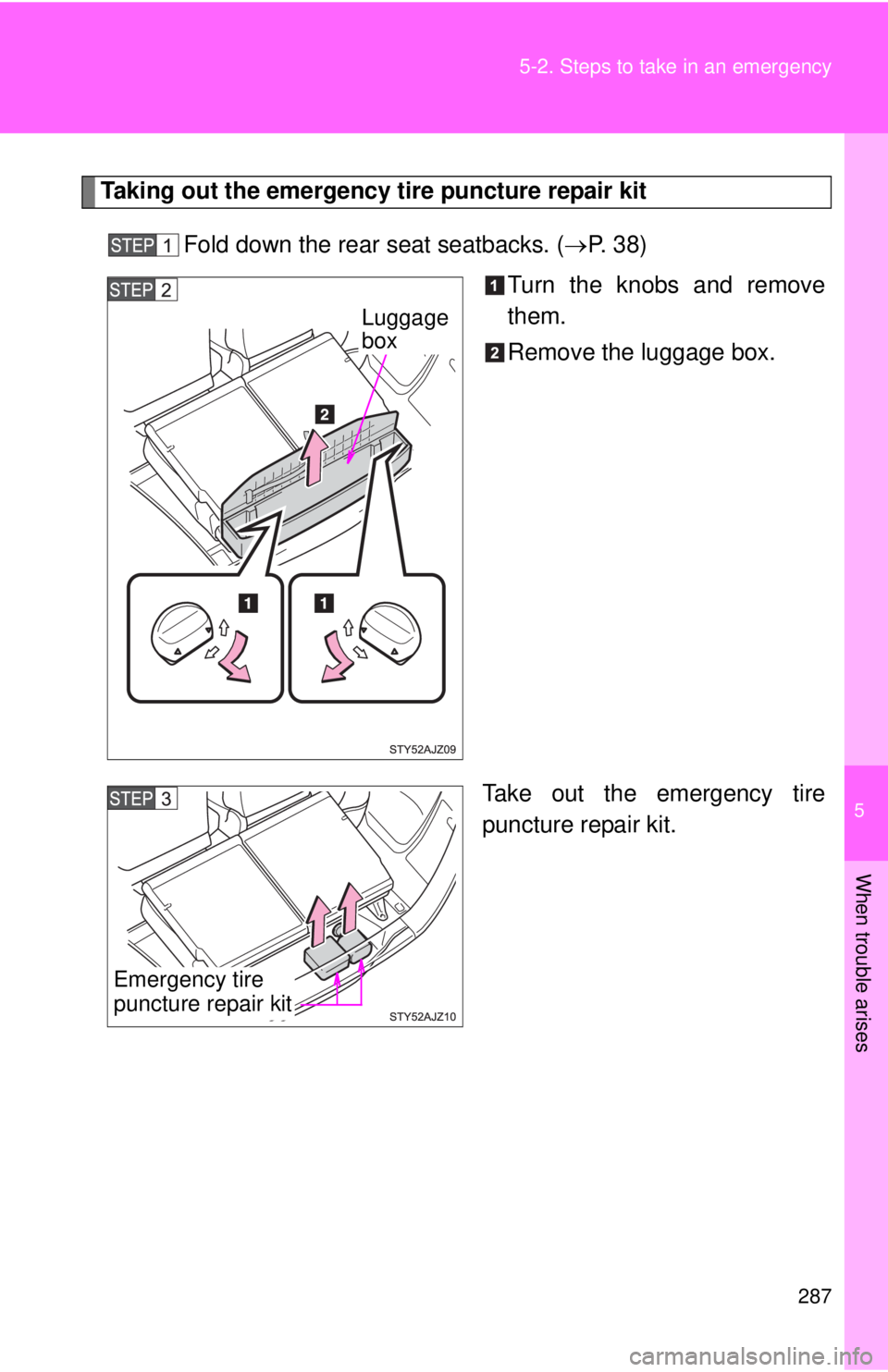
5
When trouble arises
287
5-2. Steps to take in an emergency
Taking out the emergency tire puncture repair kit
Fold down the rear seat seatbacks. ( P. 3 8 )
Turn the knobs and remove
them.
Remove the luggage box.
Take out the emergency tire
puncture repair kit.
Luggage
box
Emergency tire
puncture repair kit
Page 288 of 372
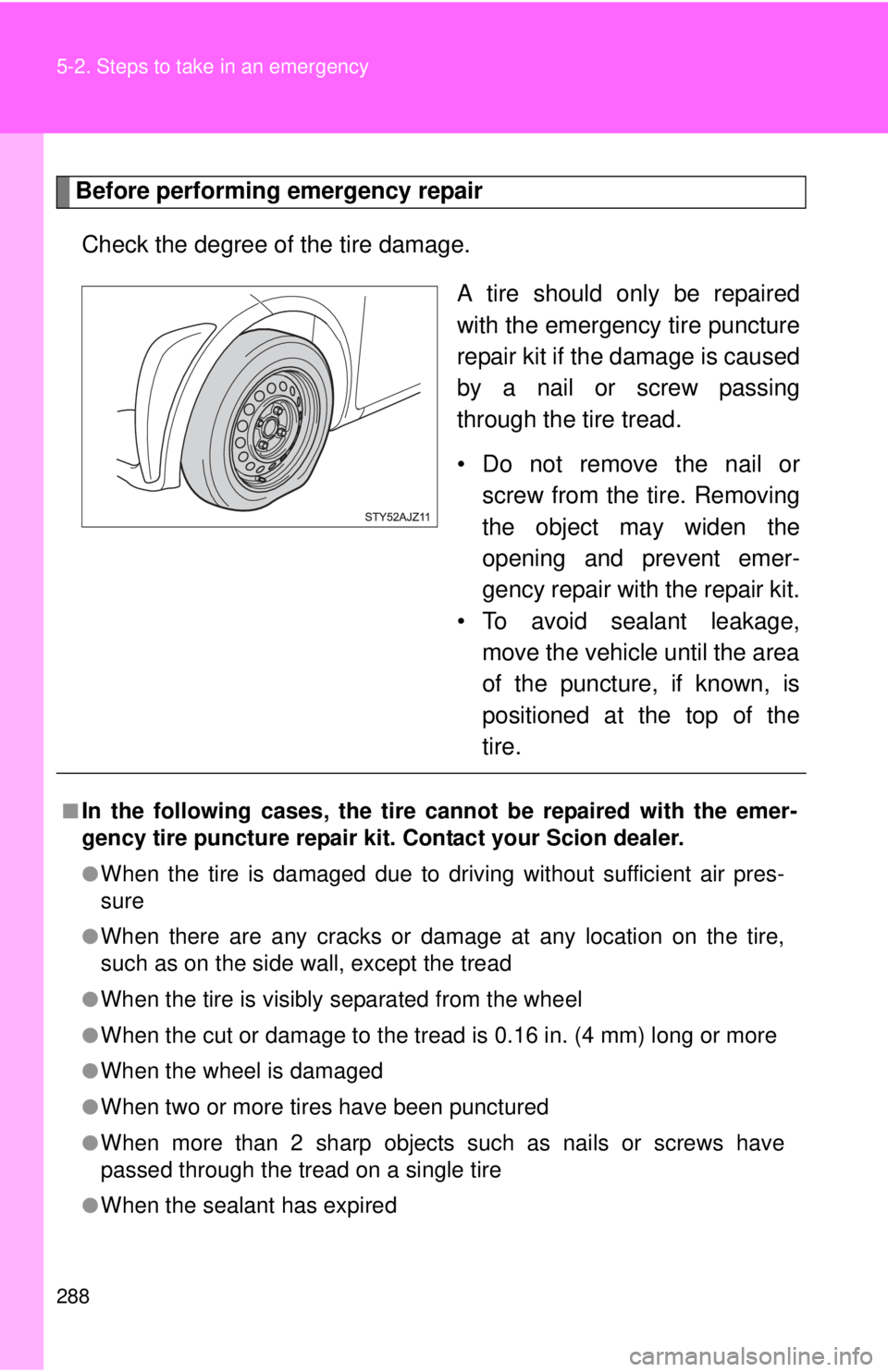
288 5-2. Steps to take in an emergency
Before performing emergency repairCheck the degree of the tire damage. A tire should only be repaired
with the emergency tire puncture
repair kit if the damage is caused
by a nail or screw passing
through the tire tread.
• Do not remove the nail orscrew from the tire. Removing
the object may widen the
opening and prevent emer-
gency repair with the repair kit.
• To avoid sealant leakage, move the vehicle until the area
of the puncture, if known, is
positioned at the top of the
tire.
■In the following cases, the tire cannot be repaired with the emer-
gency tire puncture repair kit. Contact your Scion dealer.
●When the tire is damaged due to dr iving without sufficient air pres-
sure
●When there are any cracks or damage at any location on the tire,
such as on the side wall, except the tread
●When the tire is visibly separated from the wheel
●When the cut or damage to the trea d is 0.16 in. (4 mm) long or more
●When the wheel is damaged
●When two or more tires have been punctured
●When more than 2 sharp objects such as nails or screws have
passed through the tread on a single tire
●When the sealant has expired
Page 289 of 372
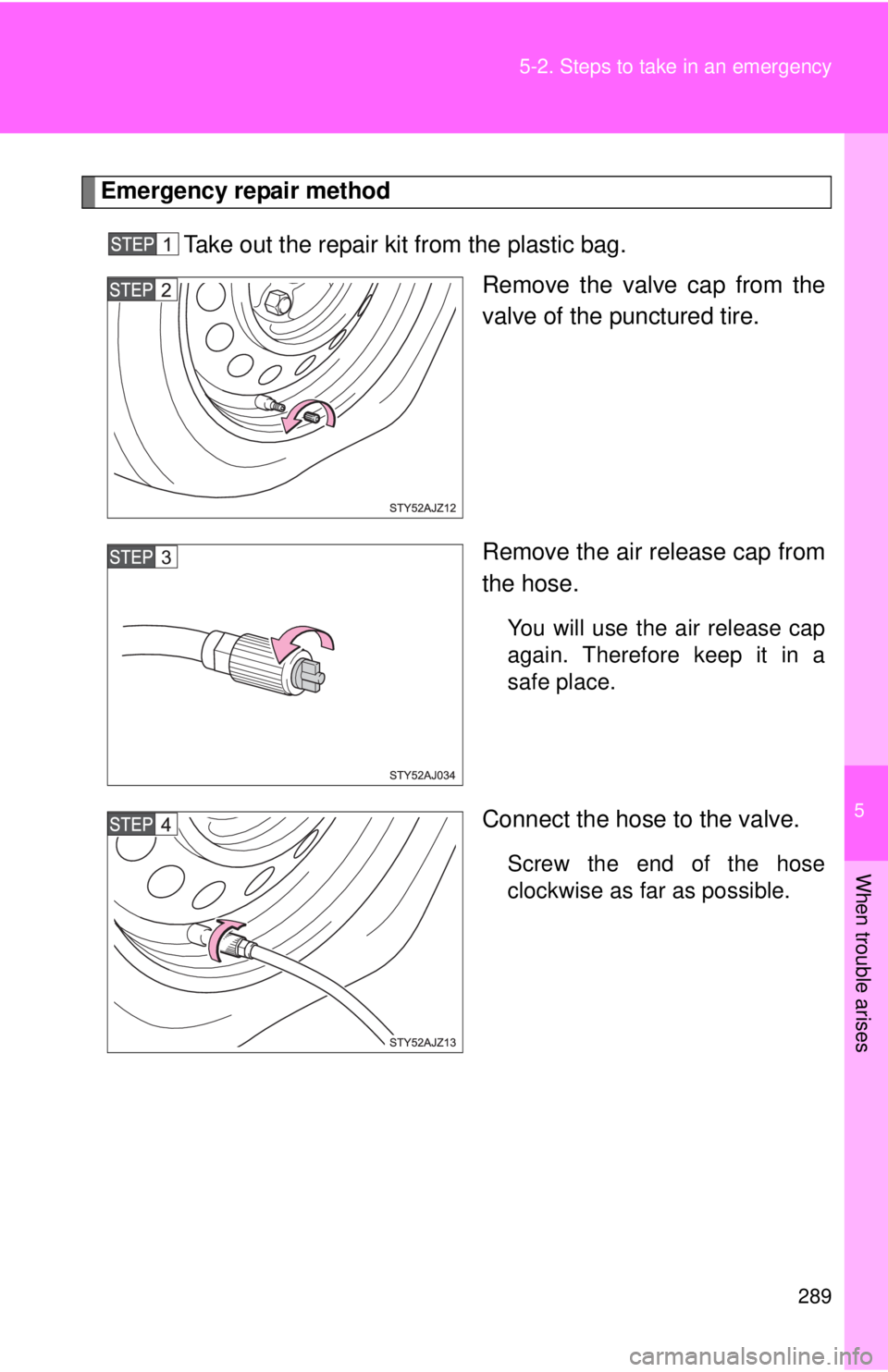
5
When trouble arises
289
5-2. Steps to take in an emergency
Emergency repair method
Take out the repair kit from the plastic bag. Remove the valve cap from the
valve of the punctured tire.
Remove the air release cap from
the hose.
You will use the air release cap
again. Therefore keep it in a
safe place.
Connect the hose to the valve.
Screw the end of the hose
clockwise as far as possible.
Page 290 of 372
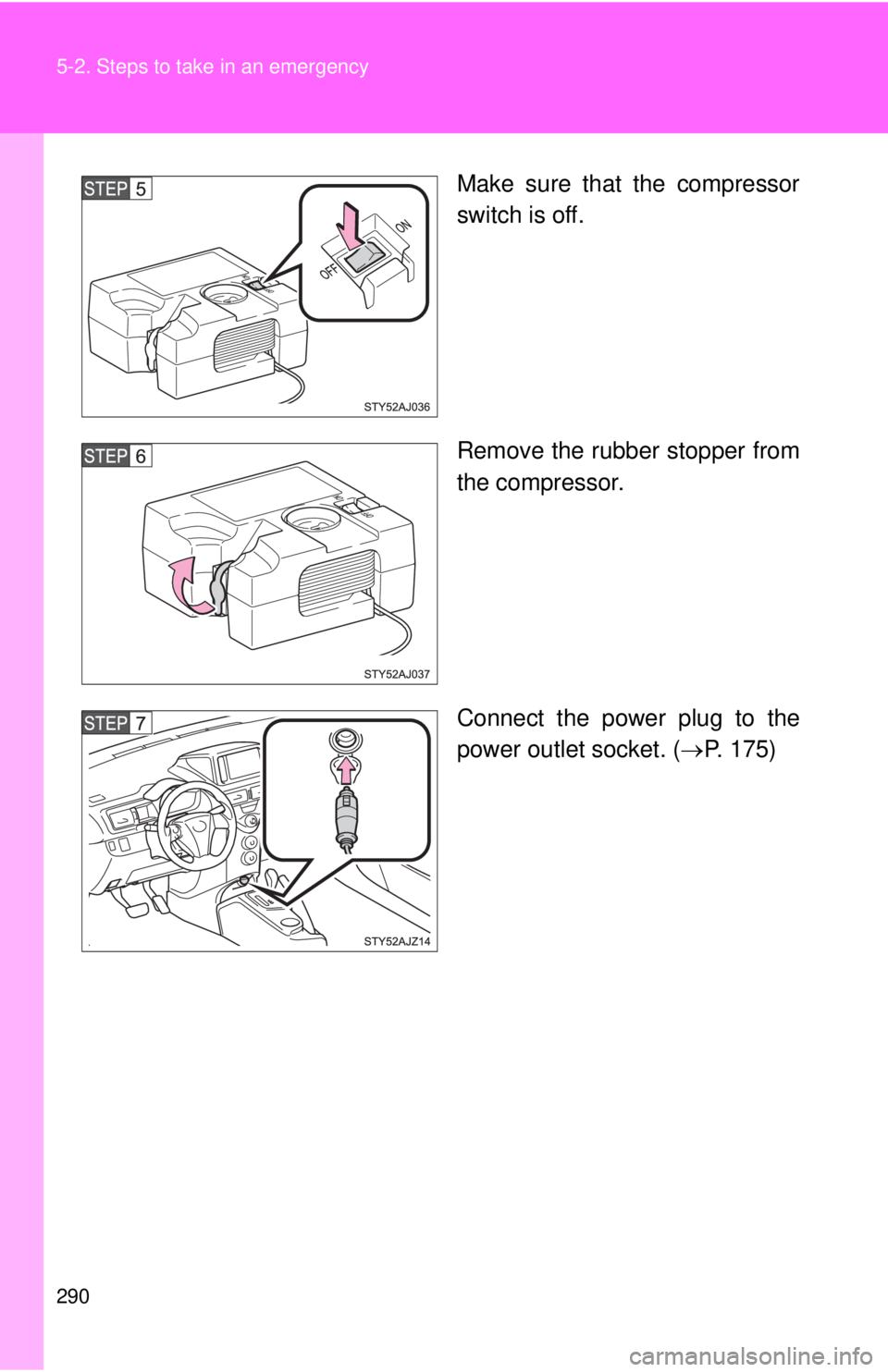
290 5-2. Steps to take in an emergency
Make sure that the compressor
switch is off.
Remove the rubber stopper from
the compressor.
Connect the power plug to the
power outlet socket. (P. 175)